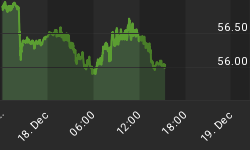Based on the September 27th, 2012 Premium Update. Visit our archives for more gold & silver analysis.
Gold prices fell more than 1 percent Wednesday pressured by a stronger dollar and weaker stocks markets along with profit-taking. Gold struggled to maintain gains after hitting six and a half month highs this month after the Federal Reserve, the European Central Bank and the Bank of Japan announced steps to loosen monetary policy.
Meanwhile, scenes of large-scale protests against anti-austerity measures in Spain and Greece rekindled fears about the eurozone's three-year-old debt crisis. Gold and the euro have been moving in tandem for quite a while now (they both are negatively correlated with the dollar). Gold is still over 5 percent higher for September. The Fed's pledge to buy $40 billion in mortgage-backed securities each month as long as job creation remains sluggish should protect gold from crashing.
But will a serious flare up of the eurozone crisis damage gold's upward trajectory? The New York Times reported that in Spain, where there is more than 50 per cent unemployment among youths, people are rummaging through garbage cans for food. Spain has been forced to embark on the same path as Greece, introducing one austerity measure after another, cutting jobs, salaries, pensions and benefits.
The gold market was kept afloat early this week by news that South Korea and Paraguay both significantly added gold to their reserves in July, highlighting strong interest in gold in the official sector. Data from the International Monetary Fund showed South Korea raised its holdings of gold by nearly 16 tons in July. The country has doubled its bullion reserves in just one year after being one of the largest purchasers of gold in 2011. The Bank of Korea has indicated that it will continue to bolster its gold holdings going forward.
It is interesting to note the sharp contrast with its impoverished sister to the north, which has very few ways to earn foreign currency. North Korea has sold more than 2 tons of gold over the past year as its economy continues to deteriorate. Cash-strapped North Korea raised roughly $100 million. Its leader, Kim Jong Un, went on a spending spree after his father's death, erecting a $40 million statue of his father, among other extravagances.
Paraguay also raised its reserves in July from a few thousand ounces to more than 8 tons. So far this year, central banks have added a net 262.1 tons to their reserves, compared with 203.4 tons in the first eight months of 2011. Turkey has added the most to its holdings, having raised its reserves by 100.2 tons in the first eight months of the year, followed by Russia, which has added 53.75 tons.
Summing up, the overall fundamental situation for gold is still very favorable. But are the recent developments in the yellow metal a mere consolidation or a beginning of a correction? We have prepared 2 charts for you today that will allow to put the recent price moves into a bigger perspective (charts courtesy by http://stockcharts.com.)
The first one features the yellow metal from the perspective of other currencies. It is a non-USD gold chart, meaning a weighted average of gold priced in different currencies, other than the USD - the weights are as in the USD Index, so this charts is similar to the one featuring gold priced in euro.

On the above chart we have seen some insignificant correction this week. It seems that a bigger correction could be seen simply because the recent move didn't correct anything (especially given Thursday's rally) meaning that the decline was not enough to change the attitude of market participants. Those who were betting on higher gold prices have not yet become discouraged by gold's performance and those who believe in the gold story and are waiting for the prices to get lower to add to their holdings, haven't done so.
We further see that the breakout above the declining resistance line has been confirmed by several weekly closes above it, but the price could still decline to this line in order to completely verify the breakout.
Let's now move on to the Japanese yen perspective.

On the above chart we see that we don't see a breakout analogous to the one mentioned above.
In fact, an important resistance line was almost reached, and it seems that it could be engaged one more time before any correction is seen. Simply put, sell signals are not crystal clear from this perspective just yet.
Summing up, the situation remains bullish for the medium term for gold, but a correction could very well be seen before the rally continues. Taking a look at the non-USD gold chart suggests just that. The price of gold suggests that the correction can start quite soon, but that it is probably not underway just yet.
In other news, we have just launched the long-awaited, new version of our website. We invite and encourate you to visit it at www.SunshineProfits.com
Thank you for reading. Have a great and profitable week!















